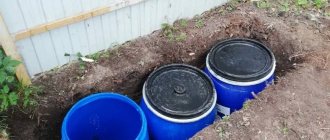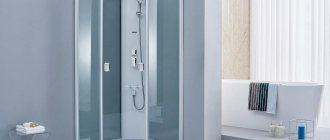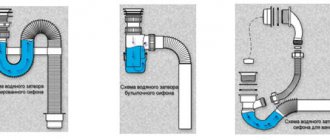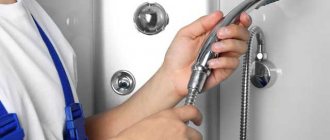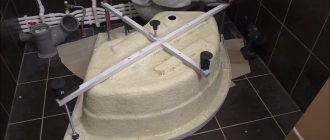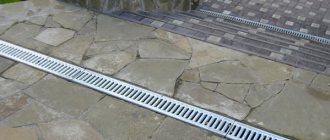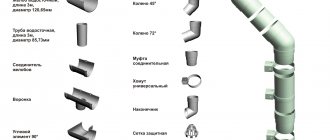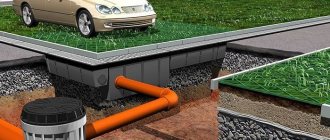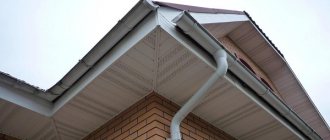In the design of a shower stall, the siphon plays a kind of intermediate role. It ensures the redirection of used water from the pan to the sewer. And its function also includes providing a hydraulic seal (better known as a water plug), which cannot always be detected due to the presence of membrane analogues that protect the apartment from the penetration of foul-smelling air from the sewer. Air from drains can be hazardous to the respiratory system and human health, as it is toxic.
The standard siphon design consists of two elements - a drain and an overflow, which is also not always present. The modern market offers consumers a wide variety and choice of a wide variety of siphons, varying in design, method of operation and size.
What is a siphon used for?
Not only the shower tray, but also all other plumbing fixtures must be connected to the drain through a siphon. The task of this element of drainage fittings is to ensure unhindered drainage of water from the shower stall into the sewer.
Manufacturers are developing new, improved models that not only drain water, but facilitate its rapid removal in a matter of seconds.
The smell from the sewer is not just unpleasant. Gases can be toxic and hazardous to health if inhaled
This creates a water plug that prevents sewer odors from passing from the pipe into the room. More detailed information about the water seal for sewerage is discussed here.
A water seal is a special siphon design. If you do not use the shower stall for a long time, the water plug may dry out. If this happens, the bathroom will fill with an unpleasant odor.
To correct the situation is very simple - turn on the water. A new hydraulic seal is formed, and the problem disappears.
Our range:
Siphon for tray AlcaPlast A491CR RUB 1,360
Siphon for tray Bas Essentia/Flow/Stella sL00094 RUR 1,475
Siphon for tray Hatria Leaf Y1D501 4630 RUR
Siphon for pallets Cezares CZR-02-90 2280 RUR
Required Tools
When installing and connecting a shower cabin to the sewer, you will need certain tools and consumables. The base is made by pouring a concrete screed, which means you should prepare a tool for preparing the solution, carrying out concrete work and applying waterproofing:
- construction mixer;
- shovel;
- measuring container;
- Master OK;
- grater;
- grater;
- putty knife;
- knife;
- scissors.
Tools for concrete screed
The cabin is connected using:
- Bulgarians;
- electric drills;
- hammer drill;
- screwdriver;
- grinding machine;
- hacksaws for metal;
- pipe bending device;
- screwdrivers;
- pliers;
- vice;
- wrenches, socket wrenches, plumbing wrenches, adjustable wrenches;
- chisels;
- chisels;
- hammer;
- mallets;
- paint brushes;
- spatula.
Cabin Connection Tools
Supplies you will need:
- polyurethane foam;
- silicone sealant;
- FUM tape;
- cuffs;
- hairpins.
Quality control and the necessary measurements are provided by a building level, tape measure, metal ruler, corner.
Classification of siphons by design
Based on their design features, there are several types of siphons:
- bottle type;
- pipe;
- corrugated;
- dry.
Separately, the presence or absence of an overflow in the design should be highlighted. All of them can be used when connecting a shower tray. When choosing a specific type, you need to take into account the presence of an overflow hole in the pan design.
If the tray for the cabin is equipped with an overflow, you definitely need an appropriate siphon, because when the tray overflows, water will simply flow through the hole onto the floor.
Such fittings can be any of the above varieties. A distinctive feature is the presence of an additional pipe connecting the siphon structure and the overflow.
The presence of such a feature as an overflow makes the use of a shower tray more practical. With sufficient depth, you can bathe a small child in it, like in a bath, or even do laundry
As a rule, the upper hole has a smaller diameter - about 4 cm. The connecting hose is made flexible - from a corrugated pipe, since the location of the overflow can vary depending on the type of shower stall, and the siphon should fit most models.
Now let's take a closer look at the main types of siphons. To understand how they work, you need to familiarize yourself with the features of each type, as well as their disadvantages and advantages.
Type #1 – bottle siphon
The first type of siphons is the bottle type. In its design it resembles a flask. A drain from a pan with a filter grid (outlet) is connected at one end, and a sewer pipe is connected at the other end.
The hydraulic seal is formed due to the fact that the outlet from the siphon is located above the edge of the inlet pipe.
There are two construction options: with a tube immersed in water, or with two communicating chambers with a partition. Both varieties are equally effective
The device is made of plastic. Sediment collects at the bottom and must be removed periodically.
To clean a bottle model, the drainage fittings must be accessible from below, and the design of standard shower trays rarely requires a comfortable height. For this reason, the classic bottle shape cannot be used for low trays.
Type #2 – pipe version with a water seal
An equally common option is a pipe siphon. It is a curved tube made of hard plastic. A bend is required.
Most often, pipe models are made in the shape of the letter “S” or the letter “U”. This configuration ensures the natural formation of a water plug in the bends.
In addition to the height of the siphon itself, it is necessary to take into account the necessary angle of deflection for normal outflow of water. The reference point is the place of insertion into the sewer pipe
Pipe siphons are compact and easily fit under the shower stall. There are modifications for pallets of any height, even the lowest ones. Thanks to the smooth inner surface of the plastic from which the device is made, contaminants do not accumulate on the walls, but are sent straight to the drain.
The main advantages of this type of drainage fittings are durability and the absence of the need for frequent cleaning.
Type #3 – corrugated siphon
The most popular siphons for low pallets are made from corrugated pipe. According to the principle of operation, they are identical to conventional pipe models, but their main feature is contained in a flexible and elastic corrugation: the siphon can be manually set to any suitable shape.
This versatility makes corrugated models suitable for all shower enclosures.
The main condition is that the bend of the siphon must be made so that the water in this place completely blocks the pipe opening. Only in this case will the hydraulic valve function correctly
The main disadvantage of this design is caused by the structure of the corrugated hose. Since its entire inner surface consists of small folds, dirt accumulates in them.
In addition, to ensure the necessary flexibility, the thickness of the hose walls is quite low, which also affects the durability of the device. The siphon quickly breaks down and requires cleaning.
Type #4 – dry siphon version
In order to ensure the minimum possible height of the siphon, manufacturers abandoned the conventional water seal in favor of a new technology for protection against sewer “odors” - a silicone membrane.
Models with such a system are called dry siphons, because water does not linger in them, but goes directly into the drain. The silicone membrane acts as a valve, allowing water to flow in the desired direction, but retaining gases from the drain.
It looks like a tightly rolled polymer tube, which straightens out and allows the flow of water to pass through, and as soon as it stops, it returns to its original position.
Another advantage of this design is that it does not freeze or dry out. Even in the presence of a heated floor - a frequent culprit of evaporation of the water seal and the appearance of unpleasant odors in the bathroom - the silicone membrane will not be damaged in any way
This feature plays an important role in rooms that are heated intermittently, for example, in a free-standing bathhouse or sauna in the country. In this situation, the presence of a siphon, which does not need to be “preserved” every time so that it does not crack due to frost due to the water remaining in it, is a significant advantage.
This type of siphon is the most expensive, but its efficiency justifies the high price. Fittings with a dry seal are installed even under the lowest shower trays, where it is impossible to install other models.
In addition to the high cost of the device itself, if the membrane becomes dirty or damaged, repairs will also be expensive.
We reviewed more detailed information on the types of shower drains in this article.
Conclusion
In this article I shared my experience and opinion, which is very subjective. I have ordinary customers, so I rarely supply premium products.
I always try to balance price=quality.
You can safely choose products from a popular and well-known European brand and it will work for you for quite a long time.
Don't go for the cheap stuff. When you make a shower drain in the floor and water leaks somewhere under the tiles, dampness and fungus will appear. This will be quite expensive to fix. As I already wrote above, replacing a tray or drain costs several tens of times more than the cost of the product and the work to install it.
I wrote my reviews about ladders and trays and talked about the nuances. If you found the article useful, please like it and ask your questions in the comments.
Manufacturers
The most popular and in demand metal-plastic models of shower siphons from domestic and foreign manufacturers:
- multi-position model WIRQUIN BOND JAMES in black from the French manufacturer Wirquin. It is distinguished by the presence of a self-centering gasket and a compact removable filter;
- model WIRQUIN Tourbillon gray from the French manufacturer Wirquin. Characterized by an ABS chrome grille and an easy to clean removable cup;
- domestic model UNICORN for deep trays with chrome-plated overflow, flexible outlet to the sewer system and a cup made of stainless steel;
- the Temporlekh Plus model from the German manufacturer Viega, which has a convenient horizontal outlet, a chrome plate and high throughput;
- the Raindrain model from the German manufacturer Hansgrohe, characterized by high productivity (51 l/min), for a water level of 150 mm and the presence of an external steel panel;
- German model Ideal Standard, characterized by a drain hole diameter of 9.0 cm and good throughput;
- Uniflex model from the Swiss manufacturer Geberit, which has the ability to dismantle the immersion pipe and its retainer, an installation height of 8.0 cm, and mobility of the outlet pipe within 15°.
Siphon for shower cabin IDO SHOWERAMA
Manufacturers produce shower siphons of horizontal and vertical types. The first option is used when the height of the shower tray is small or completely absent. In this case, the wastewater flow is directed to the side, which minimizes the size of the device.
Vertical or direct-flow siphons are characterized by water draining downward, thereby increasing the throughput of the system.
Water seals for shower cabins in St. Petersburg
Yandex Market data from 02/06/2019 14:59
Siphon for shower tray white Slim 90 mm, output 40
Designed to organize drainage of water from a shower tray with a diameter of 90 mm. Innovation. The height of the siphon is only 4 cm. The drainage speed is 33.6 l/min. Easy to clean: easy to clean from above, through the lid. Composition: polystyrene, ABS chrome plated. Explanation of marking: outlet diameter 90 mm, outlet to sewer? 40/43 mm. Gross weight: 0.37 kg.
siphon for shower tray aniplast 50 mm drain 40 mm
A siphon for installation in a shower tray (shower cabin) is designed to drain water into the sewerage system. The siphon prevents unpleasant odors from entering the room, as well as the sounds of flowing water in the sewer riser. The design of the siphon ensures rapid drainage of water and makes it easy and convenient to clean the siphon through the neck without the use of any tools. A special filter mesh in the neck catches particles that can lead to clogging.
Siphon for tray RGW Velplex QYD-06 chrome 60 mm, with dry seal
Dimensions (double): 9.5×10; 5; Material: plastic; Purpose: for pallets; Release: side; Without water seal
St. Petersburg, metro station Elektrosila, st. Blagodatnaya, 67D
Shower drain Viega 583217
Type: drain, Width: 100, Length: 100, Installation: wall-mounted, Shutter type: dry, Material: stainless steel, Shape: square
Alcaplast water seal for plastic drainage gutter P065
Alcaplast water seal for plastic drainage gutter P065
St. Petersburg, Slavy Ave., 16
siphon for shower tray aniplast 90 mm drain 40 mm
A siphon for installation in a shower tray (shower cabin) is designed to drain water into the sewerage system. It prevents the penetration of unpleasant odors into the room, as well as the sounds of flowing water in the sewer riser. The design of the siphon ensures rapid drainage of water and allows for easy and convenient maintenance of the siphon through the neck without the use of any tools. A special filter mesh in the neck catches particles that can lead to clogging.
Siphon for shower tray 1.1/2″*70 S-373 12208 JIMTEN
St. Petersburg, st. Koli Tomchaka, 32, bldg.
Siphon for shower tray adjustable 1/2″x40 with outlet
Designed to organize drainage of water from a shower tray with a diameter of 50 mm. Composition: polypropylene, stainless steel. Explanation of markings: 1.1/2″ is the diameter of the siphon outlet connection in inches, 40 mm is the diameter of the siphon connecting pipe for connecting to the pipe in mm. Gross weight: 0.350 kg.
St. Petersburg, Zheleznovodskaya, 15
siphon for shower tray aniplast 50 mm drain 40 mm click-clack
A siphon for installation in a shower tray (shower cabin) is designed to drain water into the sewerage system. The siphon prevents unpleasant odors from entering the room, as well as the sounds of flowing water in the sewer riser. The design of the siphon ensures rapid drainage of water and makes it easy and convenient to clean the siphon through the neck without the use of any tools. A special filter mesh in the neck catches particles that can lead to clogging.
Siphon for shower cabin for 40 Jimten S-134/115 012108
Siphon for shower cabin for 40 Jimten S-134/115 012108
St. Petersburg, Dimitrova, 15, bldg. 1
Siphon for shower tray ANI 1 1/2 50/60 click clak chrome E410CL
Siphon for shower tray ANI 1 1/2 50/60 click clak chrome E410CL
St. Petersburg, Dimitrova, 15, bldg. 1
Siphon for Geberit shower trays d90, water seal height 50 mm, HDPE funnel: d=50mm, Connecting pipe=HDPE 150.550.00.1
Siphon ANI for shower. pallet 1 1/2″ *50/60 click-clack, with flexible. pipe 40*50, chrome E415CL 88997
St. Petersburg, Narodnogo Opolcheniya Ave., 22
Tray siphon Triton
Dimensions (double): 13.4×9; 5; Material: plastic; Purpose: for pallets; Release: side; With water seal; Additional information: for shower enclosures and Triton enclosures Additional information: for shower enclosures and Triton enclosures
St. Petersburg, metro station Elektrosila, st. Blagodatnaya, 67D
Siphon for shower trays with 4 legs, for Geberit Setaplano shower tray, water seal height 50 mm: d=50mm 154.010.00.1
St. Petersburg, Varshavskaya, 61
Siphon for tray Cezares CZR-02-90 with water seal
Dimensions (double): 22.8×10.1; 43; Material: plastic; Purpose: for pallets; Release: direct; With water seal
St. Petersburg, metro station Elektrosila, st. Blagodatnaya, 67D
Siphon for shower tray 90 mm outlet 40 mm TOURBILLON
Designed to organize drainage of water from a shower tray with a diameter of 90 mm. High-speed drainage 30 l/min at water h 120 mm. Easy to clean. Removable cup, compact. Water seal 50 mm Composition: polystyrene, ABS chrome plated. Explanation of the marking: outlet diameter 90 mm, exit to the sewer 40 mm. Gross weight: 0.138 kg.
St. Petersburg, Zheleznovodskaya, 15
Siphon for shower tray ANI 1.1/2 50 chrome E410C
Siphon for shower tray ANI 1.1/2 50 chrome E410C
St. Petersburg, Dimitrova, 15, bldg. 1
Drain for showers and bathrooms VIEGA Advantix Vario with grate 300-1200 mm glossy chrome
Designed for rapid drainage (0.5 liters per second) and disposal of wastewater from the surface of a barrier-free shower stall. Equipment: channel made of ABS plastic without flange; siphon made of ABS plastic rotating with horizontal outlet DN40, stainless steel grate - “Wave” design, waste container, sealant, hook for removing the grate Technical characteristics: Installation: near the wall in the floor Type of shutter: wet shutter Grate material: stainless steel Length: 300–1200 Width: 40/50 Nominal
St. Petersburg, Zheleznovodskaya, 15
Choice
Parameters and characteristics that determine the choice:
- Geometric - dimensions of the shutter, height of the space under the shower stall, diameter of the drain hole;
- Technical – performance and throughput;
- Quality of material;
- Difficulty of installation;
- Operational features.
Shower cabins are often sold together with siphons. If you are satisfied with this cabin modification, you can purchase it. But just as often you have to select the siphon yourself. Therefore, you should pay attention to the following points.
Geometric parameters
The design of the tray and methods of its installation determine the choice of the mounting height of the shutter. Modifications of devices with a height of 8 to 20 cm are made. However, for a shower cabin that requires low installation, only those whose height does not exceed 10 cm are suitable. The lower the height of the device, the easier its installation will be. The most difficult thing is to select shutters for the cabin installed directly on the floor.
The market is increasingly selling shower cabins that have drain holes in Euro sizes - 52, 62 and 90 millimeters. The structural parts of the shutter must comply with them.
Technical specifications
The depth of the shower cabin sink is usually small, the water flow is large, therefore, the water must have time to come out without delay. The throughput capacity (CA) of a water seal determines the speed at which water will flow out, as well as how quickly the seal structure will become clogged and how often it will need to be cleaned. The average PS of shower cabins is 30 liters per minute. If hydromassage and other additional functions are available, water consumption increases. An indicator characterizing the SS is the height of the water layer above the level of the top of the drain. With a height h=12 cm - diameters are 5.2/6.2 cm, with h=15 cm - a diameter of 9 cm. Therefore, for low pallets there are siphons of small diameters - 50 mm, for high ones - large ones. The instructions for the shower cabin indicate the PS, which must be taken into account when choosing a shutter device.
GOST recommends a minimum flow rate of at least 15 liters per minute for shower cabins with outlet, at least 21 for siphons with overflow and for deep sinks.
Material quality
The parts located under the shower stall are not exposed to external physical stress, so they can fail due to aging of the plastic. Low-quality plastics begin to crack already in the second year of service. High-quality ones last a long time.
The grate covering the drain requires attention. The best option is when it is made of stainless steel. This is the most durable material used for gratings. There are gratings made of alloys. In this case, you should pay attention to the decorative coating. Two layers of chrome guarantee that the coating will not peel off and the grille will last a long time. Chrome is resistant to detergents, which is an additional advantage. Plastic nickel-plated grilles quickly remain without a coating that cannot be restored on your own.
To facilitate periodic maintenance of the valve device, as well as to protect against sewer odors, the valve devices are equipped with additional parts - dry or hydraulic valves, removable settling cups. The more additional parts there are, the lower the shutter reliability. The likelihood of breakdowns increases with the number of parts.
When buying cheap water seals, they waste large sums of money, since only lifting the pan will allow them to be replaced. In some cases, you will have to dismantle the entire shower cabin, then you cannot do without breaking its parts. Whether it is worth saving on the shutter device is up to the buyer to decide.
Performance
Drain fittings, according to regulations, must be easy to disassemble and assemble manually. This is an important condition, especially when the drain is clogged, or in other emergency situations. Therefore, installation of the shutter device is carried out with a minimum set of tools.
During operation, the main difficulty is cleaning the locking device. When choosing, you should think about this issue. Some modifications are made to be self-cleaning. Some can be cleaned through the drain hole. Such modifications of the bolt product have an outlet diameter of 90 mm, which allows you to disassemble the device, remove everything you need in sequence, and then reassemble what was removed in the reverse order.
When buying a siphon, it is better to choose products with click-clacks that can be removed with a cleaning basket
Materials
Drains are made of steel or special plastic. Less commonly, models are made from sanitary cast iron. Plastic models are cheaper than steel and cast iron, so they are most widespread. They are easy to clean and are not afraid of corrosion. Plastic sewer drains are simple, easy to maintain and can withstand heavy loads. They are durable and resistant to aggressive environments.
Steel ladders are recommended for installation in premises that are subject to increased requirements. These drains are made entirely of high-strength stainless steel.
Cast iron drains have increased wear resistance and throughput. They are used in the most difficult conditions. Cast iron drains can be installed not only in shower stalls, but also in toilets, swimming pools, and laboratory rooms.
Shower drains can have the following shape:
- round;
- rectangular;
- square;
- triangular;
- oval;
- extended tray.
The most popular are rectangular and square models. They are easiest to fit into the lining of the floor covering used in the shower stall.
DIY drain installation
Installing a water drainage system into a sewer involves sequentially completing the tasks of installing pipes, a siphon and a drainage system.
Shower channel
The installation of the siphon to the shower tray is carried out before the base is leveled to the floor. The upper part of the drainage fittings is attached to the inside of the pan, fixed with a bolt in the center (pre-treat with sealant).
Sequencing:
- The drain grate is covered with tape to prevent damage.
- Degrease the surface.
- The channel is attached to the floor with brackets.
- The drainage body made of metal is grounded.
- The tray is leveled.
- One edge of the hose is connected to the channel pipe.
- The second edge is attached to the sewer.
- Water leakage is checked.
- The space is filled with cement mixture and finished with tiles.
Drainage drain
Installation is carried out using a channel-type siphon. You can additionally install a drain in front of the installed shower stall to avoid leakage beyond the required limits, but such a system is rarely used.
- The location where the pipe is inserted into the water outlet pipe is determined, and a line is drawn from it to the siphon installation point.
- If the decorative elements are the same size as the ceramic elements, a flange is installed instead of 1 tile. If the ceramic squares are huge, you need to attach the ladder at the junction of the two elements.
- The drain outlet cuts into the sewer, pre-coating the joints with silicone.
If you need to install several devices (washing machine, washbasin) in one drain pipe, use models with a pass-through device and two outlets.
- The floor is laid on extruded polystyrene foam.
Siphon on the cabin tray
If there is an overflow, first install the tube in the siphon, and only then attach it to the sewer.
Assembling drainage fittings is not difficult, the main thing is to follow the instructions and carefully treat the joints of the parts with sealant. The pipe is connected on one side to the sewer outlet, and on the other side it is attached to the drain of the shower stall.
Recommendations
In order for drainage fittings to work for a long time, it is important to use high-quality sealants that are resistant to high temperatures. You should also not use inexpensive plastic siphons to provide hot water drainage; it is better to purchase stainless steel models that will last longer. Other recommendations:
- The lower level of the siphon must be higher than the level of the sewer opening.
- To clean the siphon less, you need to install a mesh on the drain.
- Before choosing drain fittings, measure the height of the tray to the floor.
Using a drain
The use of an additional drainage system is relevant if the shower stall is of a combined or open type.
Then there is a risk of water getting beyond the sides. If the cabin has a high tray, then this application is not relevant.
To save money, you can install a double siphon, which will receive water from the shower tray and drain. You need to choose stainless steel models.
Prices
It must be said that it is not possible to find a case made of steel or bronze. In any case, polypropylene is used (for its low temperature coefficient of expansion). That is, it is useless to search and find exotic options. If steel or bronze appears in the design, it is in the form of a drain plug. And the pipes and water seal are made of polypropylene.
The price of a siphon depends on several factors:
- The presence of a water seal (cuts off unpleasant odors).
- Manufacturer country.
- Guarantee period.
Regarding the warranty period, one thing can be firmly said: the dealer does not always undertake to provide the characteristics declared by the manufacturer. As a result, the period of free repair and replacement drops to one year or even six months (according to the receipt). In light of the current situation, more and more buyers are choosing Chinese products.
Using a drain
Previously mentioned was the miracle of the modern plumbing market known as the drain drain. This device is perfect for use in combination with shower trays of a wide variety of heights. It is important to understand that the drain has certain dimensions, and there must be enough space between the floor surface and the underside of the upper edge of the shower tray to install the plumbing product.
If the shower tray is installed on adjustable legs or a support frame, no problems will arise - the required height of the tray is set, the drain ladder is installed (guidelines for its assembly/disassembly and correct placement will be given below), the drain is connected to the sewer, after which the space between the floor and the pallet is covered with a decorative screen or masked in another suitable way.
Plumbing drains Shower drain Viega Advantix Corner drain Viega corner drain
It’s a different matter if the owner bought an almost completely flat pallet. In this case, you will have to resort to a trick, using one of the options discussed in the following table.
Table. Options for installing a flat tray for connecting a siphon
| Installation option | Description |
| Installation on a wooden pedestal | The bottom line is this: a pedestal is assembled from wooden boards (in fact, a durable hard box without top and bottom edges) and a shower tray is placed on it. For assembly, use boards with a length along the sides of the pallet, a height sufficient to install a ladder of the selected dimensions, and a thickness of 4 cm or more, so that the structure can easily support the weight of the pallet and the washing room visitor standing on it. The boards are fastened inside with corners and tightened with screws/screws. As a result, it becomes possible to install a drain and connect it to the sewer pipe. The method is extremely simple and inexpensive, but has a big drawback: fragility. Ultimately, the boards will still begin to rot from use in such conditions. To delay this moment, firstly, use the highest quality material, and secondly, be sure to treat it with a special antiseptic impregnation, which helps increase the moisture-repellent properties of the wood. |
| Installation above a sewer pit | A simple option that does not require much effort to implement. A small pit is built under the future installation site of the shower tray (one of the popular size variations will be presented after the table). The resulting free space will allow you to easily accommodate a drain ladder (it does not need a rigid base) and connect it through a corrugated pipe to the sewer. The hole shown can be made even with a finished floor already installed. It is enough to mark an area on the floor according to the shape and size of the shower tray (the sides, as shown in the figure, will rest on the floor) and cut the wood in accordance with the markings. |
Example of a pit Scheme for using a pit The procedure for installing a shower tray on a base made of blocks deserves special consideration (foam concrete and the like are suitable, if desired and the overall dimensions are satisfactory, it can even be a brick or cinder block). The instructions are given in the table.
Important! The same manual will show you the procedure for installation, connection and subsequent actions with the drain. Apart from arranging the supporting structure, the work steps remain identical.
Table. Installing a pallet on a block base
| Work stage | Description |
| Marking | Place the pallet on the floor at the installation site and trace the contours of the product with a pencil. |
| Installation of support blocks | Place 4 pre-cut support blocks (you can use a hand saw) onto the pieces at the required height. Make sure that the resulting free space under the pallet is sufficient to accommodate the siphon/drain structure. Do not forget to waterproof the base under the blocks with any available rolled material, securing it with mastic. |
| Control pallet laying | Place the pallet on blocks. Check whether the structure is stable, whether there are excessive distortions (pallets are often installed with a slope of 2-5 degrees in the direction of the drain to ensure efficient drainage of water) and whether there is enough space under the pallet for the siphon/drain of the selected model. If everything is fine, remove the pallet and begin fixing the blocks. |
| Fixing the supports | Apply tile adhesive to each support one at a time and secure all 4 blocks to the floor. |
| Marking the drain hole | Place the tray on stands and use a pencil to mark the location of the drain hole on the floor. Remove the tray. |
| Siphon connection | Connect the siphon to the sewer pipe. The connection locations and fasteners used are shown in the figure. If necessary, use a corrugated pipe and/or adapters, depending on the specifics of the sewer pipe entering the room and its characteristics. |
| Completing the base structure | Following the already familiar technology, install support blocks around the entire perimeter of the pallet. |
| Preparing the base for laying the pallet | Apply tile adhesive around the perimeter of the supporting structure. Spread the glue into a thin layer. |
| Pallet installation | Place the pallet on the resulting support structure. To fix the pallet, carefully tap its sides with a wooden hammer, while controlling the position of the structure with a building level. |
| Installing a siphon in a tray | Install the corresponding part of the siphon into the pan through the sealing gasket. As a rule, this part is screwed into the drain hole using a special tool included in the kit (shown in the image). |
| Sealing | Apply silicone sealant along the joints of the pallet with the walls. Finish the block support with tiles of your choice. You can also use an overhead decorative screen or other suitable options at your discretion to disguise the base. |
Video - Installing a shower tray on a block base
The above guide showed how to connect a compact siphon (drain) for a low shower tray. In general, the sequence of actions remains the same for all existing models of the mentioned plumbing products, however, in order for the installation to be quick and easy, it is necessary to have a complete understanding of the design of the drain and, most importantly, the process of its independent disassembly/assembly.
The design of the ladder is shown in the following table.
Table. Drainage design
| Design element | Image |
| Gangway assembly | |
| Disassembled gangway | |
| Overlay | Overlay |
| Siphon | |
| Flange with swivel fixing screws | |
| System for connecting to a sewer pipe. Complete with gasket. |
Video - Drain drain design
You can familiarize yourself with the procedure for disassembling the ladder yourself for its subsequent installation in the following table.
Table. The procedure for disassembling the drain ladder
| Work stage | Description |
| Removing the trim | We pry the cover with a screwdriver, as shown in the figure, and remove it from the fasteners. Next, remove the mesh, if present. |
| Taking out the “core” | To get to the mounting screws, remove the middle part of the structure (shown in the figure). To do this, carefully pry up its edges with a screwdriver, like the top cover, and remove it. |
| Unscrew the fasteners | Their number may vary depending on the specific design. In the example under consideration there are two fasteners. |
| Removing the top part of the system | After unscrewing the screws, remove the upper part of the system. This part is installed in a pallet. |
| The lower part of the system is located in the space under the pallet | There is an outlet for connecting to a sewer pipe. Assembly is carried out in reverse order. |
Video - Dismantling the drain ladder
The siphon, a plumbing element invisible at first glance, performs very important functions in the system under consideration. In order for the structure to serve as long and efficiently as possible, try to initially purchase a high-quality plumbing product, or even better, use the unit included in the shower cabin, if present.
If you buy an extremely budget siphon from a little-known manufacturer, you run the risk of encountering many problems in the future associated with the need to very often clean the system or even repair it as quickly as possible.
Design features
In addition to the stylish design, the design with a drain has many advantages: it takes up little space and makes the bathroom interior more functional and comfortable. To decorate the walls and floors, use traditional tiles, mosaics or waterproof wall panels. The partition is most often made of transparent or frosted tempered glass. Despite its external lightness, such a shower has excellent sound insulation.
It is convenient to organize such a shower in a niche
One of the main requirements for organizing a shower with a drain in the floor is the installation of high-quality waterproofing. As for the configuration of the shower, there are no restrictions. The minimum size is 100 x 100 cm. The shape in plan can be square, rectangular, and in a small room you can completely abandon the partition.
The corner location of the shower is emphasized by the decoration of adjacent walls
Expert opinion: Masalsky A.V.
Editor of the “construction” category on the Stroyday.ru portal. Specialist in engineering systems and drainage.
If you decide to renovate your bathroom yourself, it is recommended to start with a drawing. It is necessary to reflect the layout of the drain and sewage system, the layout of the tiles, and the places where the equipment is attached. The drain can be located in the center of the shower or near the wall.
Types of designs
There are two ways to arrange a shower: with a ladder or a podium.
A shower with a drain cannot be installed in every room. It is necessary to fill the screed to a certain height. Initially, it is better to provide for this moment at the stage of building a house. Otherwise, you will need to make a step or raise the floor structure in the room.
When making a drawing, note the dimensions of the shower, its design features, its location and drain hole. To ensure that water is drained from the floor surface without problems, installation time and materials are reduced, it is advisable to place the drain as close to the sewer pipe as possible.
Installation of drain in screed
To make the shower structure airtight, you will need two layers of screed and a layer of waterproofing material (coating mastic or roofing felt). The pipes are located inside the screed. The drainage can be point or linear. If you disassemble the floor structure layer by layer, it consists of:
- Concrete base.
- Expanded polystyrene.
- Ties.
- Waterproofing material.
- Second layer of screed.
- Decorative moisture-resistant coating (tiles, mosaics).
This type of shower can be equipped with a partition with or without a door.
The tiles are laid with a slope towards the drain hole
A shower with a podium can be installed in any room; this does not require upgrading the floor structure to install a drainage system. A podium with small sides is installed above the floor level. The floor is also tiled with a slope towards the drain.
Structurally, the podium consists of a metal support and brick sides.
Shower room with podium
Before the purchase
When choosing a shower siphon that is right for you, it is recommended to take into account a number of nuances.
Among them, the most important is the diameter of the drain hole. According to European standards, it should be 52, 90 and 62 millimeters. Most often, modern varieties are produced with precisely these diameters, but there are often cases when a careless manufacturer does not comply with the technology. To avoid trouble, be sure to measure the diameter of the drain before purchasing. The second important characteristic that is worth paying attention to is the throughput parameter. It is determined from calculations of the permissible water layer for the pan
At a level of no more than 12 centimeters, use a shower siphon with a diameter of 52 and 62 mm; if the value is higher, then it is better to purchase a design with a neck of 90 millimeters.
Cleaning
Since, in addition to the drainage function, shower siphons also perform a protective role, it is recommended to clean them by hand from time to time. Over time, a huge amount of dirt and hair accumulates in the structure. In addition, the advantage of such a device is the ability to return them if small objects fall into the drain.
To clean the siphon (which, by the way, can be done without waiting for blockages, at least for the sake of prevention), you need to unscrew the elbow and clean out all the dirt and residues accumulated in it. For particularly heavy stains, you can use a rough brush to remove stubborn dirt. For lazy people, a shower siphon that can clean itself will be a godsend.
Exploitation
Sink valves are easy to operate. Care consists of control and timely cleaning (if necessary). To clean the shutter device, remove the grate, remove the water seal from the glass, and remove deposits. In general, mechanical cleaning is rarely resorted to. To make siphons less likely to become clogged, experts recommend cleaning the sealing product once every six months as a preventative measure. This is done using household chemicals suitable for plastic structures.
If a blockage occurs, air purging of the hydraulic seal under high pressure is unacceptable. It can lead to rupture of parts of the structure. It is also unacceptable to try to remove debris with sharp objects, as this can damage the walls of the corrugated pipe or other parts of the valve structure.
Varieties
Based on the mechanism of action, all siphons are classified into three main groups.
Ordinary - the standard and most common option, with which most consumers are familiar. The operation scheme of an ordinary siphon is as follows: when the plug is closed, water collects in the container; When the plug is opened, the water goes into the sewer drain. Accordingly, such units have to be controlled entirely manually. These siphons are considered completely outdated, although they are the cheapest, budget ones. Therefore, most often they are preferred to more modern models with an improved mechanism.
- Automatic - these models are mainly designed for high pallets. This design has a special control handle, thanks to which the user independently opens and closes the drain hole.
- With Click&Clack design – it is the most modern and convenient option. Instead of a handle, there is a button that is located at the level of the foot. Therefore, if necessary, the owner can press to open or close the drain.
More often there are models reaching 8 - 20 cm, so for low containers a low siphon is accordingly needed.
Price
The average cost of models with an optimal price-quality ratio is quite affordable for the average consumer:
- WIRQUIN BOND JAMES - 900-950 rubles;
- WIRQUIN Tourbillon - 430-440 rubles;
- UNICORN - 700-990 rubles;
- Temporlekh Plus - 3300-3400 rubles;
- Raindrain - 1300-4800 rubles;
- Ideal Standard - 2300 rubles;
- Uniflex - 2400 rub.
The cost in most cases varies depending on the design features of the siphon, as well as the material used in the manufacture, brand awareness and the manufacturer’s pricing policy.
When choosing, not only the technical characteristics of the siphon are taken into account, but also its diameter, which affects the tightness of the connection being made..
Siphons are distinguished by the color scheme of the decorative cover, which can be gold, bronze and white, as well as chrome-plated.
Shower stall designers regularly develop newer siphon models with a reduced height, making it possible to make the installed bottom part of the tray convenient for use not only by children and the elderly, but also by persons with disabilities.
Product management nuances
Often during operation of the pan there is a need to control the water level, that is, it will need to be made larger or smaller.
This can happen when washing a child, doing laundry, warming up the structure, to provide greater comfort, and so on. In such situations, you will have to close the drain hole of the siphon to stop the drainage of liquid.
Cheap way to adjust
To perform the described procedure, the drain fittings are equipped with various devices and mechanisms.
There are 3 main control options:
- using a cork;
- automatic;
- click-clack option.
Each of these methods has its own advantages and disadvantages, which makes using the pallet more comfortable or vice versa. It also has a significant impact on the cost of the siphon.
Such a device as a cork is familiar to everyone, as it has found its place in the designs of bathrooms and showers since archaic times. To use it to block or open the drain hole. a person has to perform a number of not always convenient manipulations.
A siphon plug is the simplest way to control the drain, and the chain will prevent it from rolling away somewhere at the most inopportune moment
It has only one drawback, but today it is significant - the need to come into contact with water, which is especially unpleasant when it is contaminated.
If the above minus does not impress you, then you can safely buy a siphon equipped with a stopper. Moreover, it will help save money, because it belongs to budget fittings. Other options will significantly increase the cost of purchasing drainage equipment.
Automatic control option
This method makes the drain control procedure more comfortable. An automatic siphon is a common product belonging to one of the above types. Additionally, it is equipped with a lever connected to a damper that closes the drain hole upon command.
For comfort, the control is installed in the area of the mixer. That is, a person does not need to come into contact with contaminated water, bend over, or perform any other inconvenient manipulations. This is the main advantage of any automatic siphon, but its cost becomes noticeably higher.
What is a Click-clack button?
This is the most modern way to control the discharge of contaminated water. Click-clack is a valve installed on the drain hole that changes position when pressed with your foot.
That is, during the first manipulation, the drainage of fluid stops, and during the second operation, it opens.
The click-clack button is the most modern and convenient way to control the drain, as it is always in the right place and does not require significant effort
The valve is installed in such a way that it is always convenient to operate, even for people with different physical abilities.
Tangible advantages are the absence of additional work during installation, since this mechanical plug is part of the siphon. Unlike the automatic siphon lever, which must be mounted separately.
In addition, the click-clack valve is reliable and attractive in design. An obvious disadvantage is that the cost of siphons equipped with this device is not the most affordable, which does not contribute to their mass distribution.
At the same time, a potential buyer should pay attention to the feature of a low pan - it is less designed for regulating the water level than a deep one. Therefore, the advantages that the rather expensive automatic siphon and click-clack provide are partially neutralized in this case
This indicates that the owner of a low pallet should think carefully about whether he needs to overpay for expensive options with reduced efficiency. Or simply limit yourself to using a cheap and familiar cork on a chain, so that a valuable device does not get lost at certain moments.
Since low trays have a slight depth, in most cases there is no hole for an overflow
Therefore, it is worth paying attention to the fact that there is no such practical function as overflow on siphons intended for low-sided products
Model types
The siphon for the shower tray is classified into the following types:
The first model is presented in the form of a U-shaped or S-shaped segment. At the top of the structure there is a water seal, and at the bottom there is a hole through which the blockage is removed. The entrance part of the structure is screwed to it, and the other end of the ladder is screwed to the sewer pipe.
The functions of the hydraulic valve are performed by bending a polypropylene pipe, which bends easily. It can be fixed in any position using a clamp.
If there is limited space to install a shower stall, then a corrugated siphon is used. Its advantages include the presence of a connecting unit located at the outlet of the pallet. This design minimizes the likelihood of leaks.
The disadvantage of a corrugated drain is that the folds quickly become clogged and deform under the influence of temperature. But when compared with other models, it is less durable and reliable.
The bottle siphon for the shower tray is equipped with a pipe at the top, the end of which is fixed to the drain. Due to the special location of the hole in the cavity of the structure, a shutter is formed.
The bottle siphon is large in size and takes up significant space during installation. Such systems are often used for high pallets. But the bottle model is easy to install.
Experts advise equipping shower cabins with drains. They are mounted in a standard hole or in a concrete base, which performs its functions. If a drain ladder is used, the waste flows through the grate into a pipe fixed to the sewer system.
Similar siphons are used to provide complete drainage of wastewater from cabins that do not have traditional trays. In this case, the siphon is mounted under the screed, maintaining a height of up to 200 mm.
Exploitation
Sink valves are easy to operate. Care consists of control and timely cleaning (if necessary). To clean the shutter device, remove the grate, remove the water seal from the glass, and remove deposits. In general, mechanical cleaning is rarely resorted to. To make siphons less likely to become clogged, experts recommend cleaning the sealing product once every six months as a preventative measure. This is done using household chemicals suitable for plastic structures.
If a blockage occurs, air purging of the hydraulic seal under high pressure is unacceptable. It can lead to rupture of parts of the structure. It is also unacceptable to try to remove debris with sharp objects, as this can damage the walls of the corrugated pipe or other parts of the valve structure.
